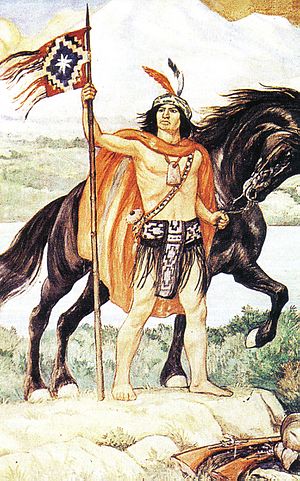Toqui facts for kids
A Toqui (or Toki) is a special leader chosen by the Mapuche people. The Mapuche are native people who live in Chile and Argentina. They choose a Toqui to lead them when they are at war. The word "Toqui" comes from their language, Mapudungun, and it means "axe" or "axe-bearer."
A Toqui was chosen in a big meeting called a coyag. At this meeting, the main leaders, called loncos, from different groups of Mapuche families would come together. Once chosen, the Toqui had full command over all the warriors and their loncos during the war. The Toqui would organize the fighters into groups and pick other leaders for them. A Toqui stayed in charge until they were killed, decided to step down, or were removed by another meeting if they were not leading well. Their command also ended when the war they were chosen for was over.
Some Toquis became very famous during the Arauco War against the Spanish. They came up with new and clever ways to fight. For example, Lautaro taught his soldiers how to fight against Spanish horsemen on foot. Lemucaguin was the first Toqui to use firearms and cannons in battle. Nongoniel was the first to use Mapuche horse riders in the army. Cadeguala was the first to successfully use Mapuche cavalry to beat Spanish cavalry. Anganamón had his foot soldiers ride horses so they could keep up with the fast cavalry. Lientur started a new plan of making many quick attacks, called malóns, into Spanish lands.
The most famous Toqui was an older leader named Paillamachu. He spent a lot of time planning, training his army, and getting them ready. Then, with his two younger helpers, Pelantaro and Millacolquin, he led a huge uprising from 1598 to 1604. This revolt finally pushed the Spanish out of the Mapuche land called Araucania.
List of Mapuche Toquis
Here is a list of Mapuche leaders who were named Toquis:
- Malloquete 1546 †
- Ainavillo, Aynabillo or Aillavilú 1550 †
- Lincoyan 1551–1553
- Caupolicán 1553–1558 ††
- Lautaro Vice Toqui 1553–1557 †
- Turcupichun 1557–1558 ††
- Lemucaguin or Caupolicán the younger 1558 †
- Illangulién, Quiromanite, Queupulien or Antiguenu 1559–1564 †
- Millalelmo or Millarelmo or Antunecul 1562–1570
- Loble or Lig-lemu or Lillemu Vice Toqui 1563–1565
- Paillataru 1564–1574
- Llanganabal 1569
- Paineñamcu or Paynenancu, originally Alonso Diaz 1574–1584 ††
- Cayancaru or Cayeucura 1584
- Nongoniel or Mangolien 1585 †
- Cadeguala or Cadiguala 1585–1586 †
- Guanoalca or Huenualca 1586–1590
- Quintuguenu 1591 †
- Paillaeco 1592 †
- Paillamachu 1592–1603
- Pelantaro Vice Toqui
- Millacolquin Vice Toqui
- Huenecura or Huenencura 1604–1610
- Aillavilu, Aillavilú II, Aillavilu Segundo 1610–1612
- Anganamón, Ancanamon or Ancanamun 1612–1613
- Loncothegua 1613–1620
- Lientur 1621–1625
- Levipillan Vice Toqui
- Butapichón or Butapichún 1625–1631
- Quepuantú or Quempuante 1631–1632 †
- Butapichón or Butapichún 1632–1634
- Huenucalquin 1634–1635 †
- Curanteo 1635 †
- Curimilla 1635–1639 †
- Lincopinchon 1640–1641
- Clentaru 1655
- Mestizo Alejo or Ñancú 1656–1661 @
- Misqui 1661–1663 †
- Colicheuque 1663 †
- Udalevi 1664–1665 †
- Calbuñancü vice toqui 1664–1665 †
- Ayllicuriche or Huaillacuriche 1672–1673 †
- Millalpal or Millapán 1692–1694
- Vilumilla 1722–1726
- Curiñancu 1766–1774
- Lebian Vice Toqui
† Means they were killed in battle. †† Means they were executed for fighting against the rulers. @ Means they were assassinated (killed by surprise).
See also
 In Spanish: Toqui para niños
In Spanish: Toqui para niños



